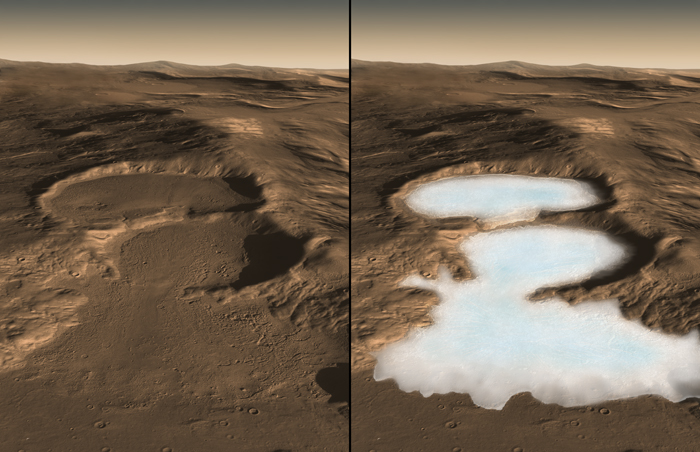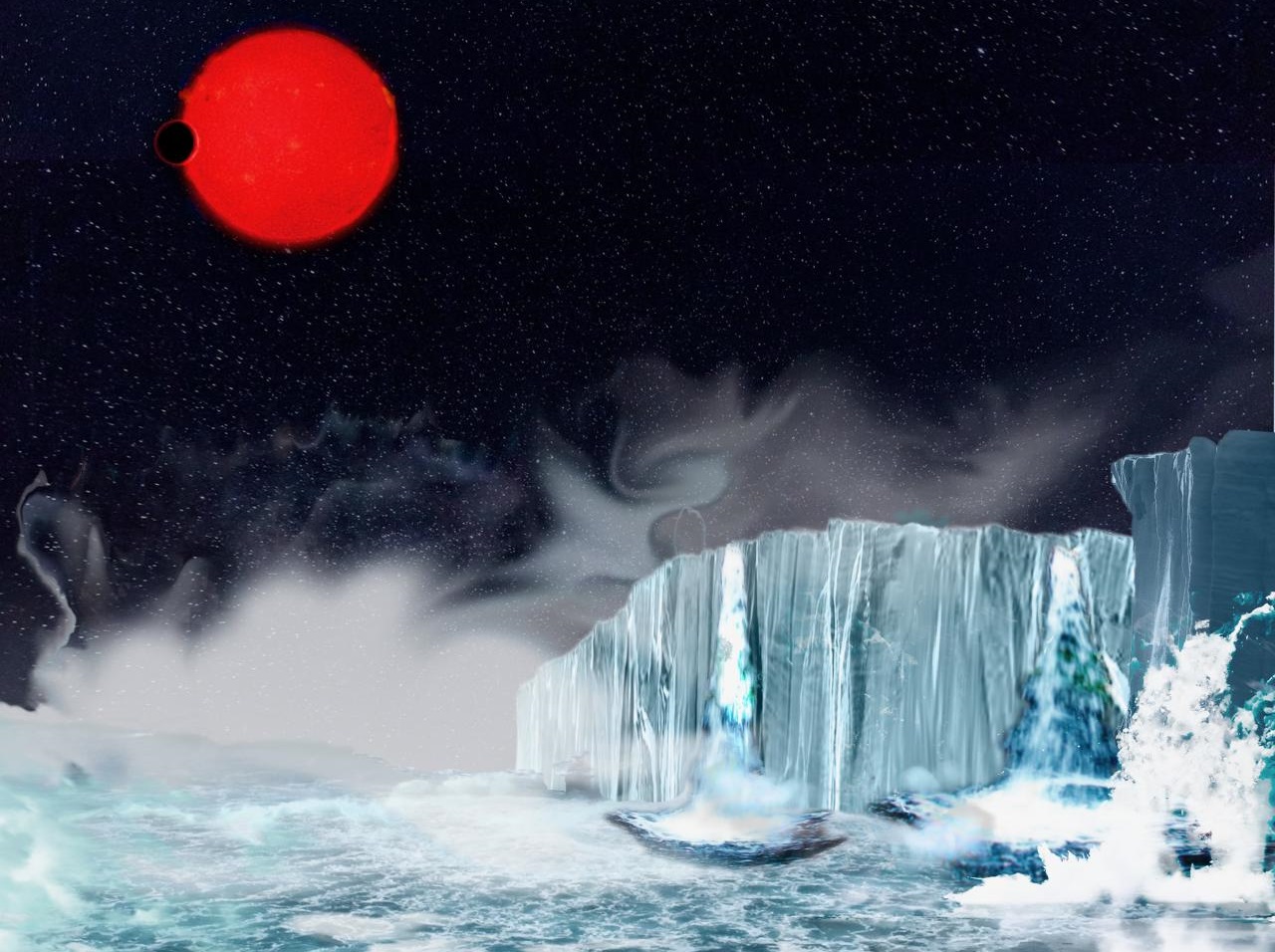I've got a file (actually a dozen files) of cool science stories that I might use in science fictional world-building. What sf author doesn't? Even fantasy stories need good science. For instance, an urban fantasy involving werewolves really should depict the phases of the moon accurately. This week, images and data from the Hubble and James Webb Space Telescopes have furnished a treasure trove of research ideas. Rather than post them separately, I've gathered a few that I find particularly exciting.
There Could be Many Water Worlds in the Milky Way
Astronomers are curious about how many terrestrial planets in our galaxy are actually “water worlds.”These are rocky planets that are larger than Earth but have a lower density, which suggests that volatiles like water make up a significant amount (up to half) of their mass-fraction. According to a recent study by researchers from the University of Chicago and the Instituto de Astrofísica de Canarias (IAC), water worlds may be just as common as “Earth-like” rocky planets. These findings bolster the case for exoplanets that are similar to icy moons in the Solar System (like Europa) and could have significant implications for future exoplanet studies and the search for life in our Universe.
“We have discovered the first experimental proof that there is a population of water worlds, and that they are in fact almost as abundant as Earth-like planets. We found that it is the density of a planet and not its radius, as was previously thought, which separates dry planets from wet ones. The Earth is a dry planet, even though its surface is mostly covered in water, which gives it a very wet appearance. The water on Earth is only 0.02% of its total mass, while in these water worlds it is 50% of the mass of the planet.”
However, planets around M-type stars typically orbit so closely that they are tidally locked, where one side is constantly facing toward its sun. At this distance, any water on the planet’s surface would likely exist in a supercritical gas phase, increasing their sizes. As a result, Luque and Pallé theorized that in this population, water is bound to the rock or in closed volumes below the surface, not in the form of oceans, lakes, and rivers on the surface. These conditions are similar to what scientists have observed with icy moons in the outer Solar System, such as Jupiter’s moon Europa and Saturn’s moon Titan.
Given that they are tidally locked to their suns, these planets may also have liquid oceans on their sun-facing side but frozen surfaces everywhere else – colloquially known as “eyeball planets.” While astronomers have speculated about the existence of this class of exoplanet, these findings constitute the first confirmation for this new type of exoplanet. They also bolster the growing case for water worlds that form beyond the so-called “snow line” in star systems (the boundary beyond which volatile elements freeze solid), then migrate closer to their star.
 |
| In the past, glaciers may have existed on the surface of Mars, providing meltwater during the summer to create the features we see today. Credit: NASA/JPL-Caltech/ESA |
Mars Had Moving Glaciers, but They Behaved Differently in the Planet's Lower Gravity
On Earth, shifts in our climate have caused glaciers to advance and recede throughout our geological history (known as glacial and inter-glacial periods). The movement of these glaciers has carved features on the surface, including U-shaped valleys, hanging valleys, and fjords. These features are missing on Mars, leading scientists to conclude that any glaciers on its surface in the distant past were stationary. However, new research by a team of U.S. and French planetary scientists suggests that Martian glaciers did move more slowly than those on Earth.
These findings demonstrate how glacial ice on Mars would drain meltwater much more efficiently than glaciers on Earth. This would largely prevent lubrication at the base of the ice sheets, which would lead to faster sliding rates and enhanced glacial-driven erosion. In short, their study demonstrated that lineated landforms on Earth associated with glacial activity would not have had time to develop on Mars.
In addition to explaining why Mars lacks certain glacial features, the work also has implications for the possibility of life on Mars and whether that life could survive the transition to a global cryosphere we see today. According to the authors, an ice sheet could provide a steady water supply, protection, and stability to any subglacial bodies of water where life could have emerged. They would also protect against solar and cosmic radiation (in the absence of a magnetic field) and insulation against extreme variations in temperature.
If Jupiter's Orbit got Weirder, it Would Actually Make Earth More Habitable
Earth is not just habitable, it’s unusually habitable. It’s rather wet for a planet so close to its Sun, it’s geologically active, and it has a stable orbit, all of which are necessary for life as we know it. But there are also secondary advantages, such as not being constantly bombarded by large asteroids, and having a rotational axis that is fairly stable. This is due in part thanks to the planet Jupiter. The giant planet has helped clear the solar system of asteroid debris and may have helped stabilize the orbits of the inner planets. So life is good. But a new study shows that if Jupiter had a different orbit, life could be even better.The study looked at the way Jupiter affects Earth’s orbit and axial tilt over time. In this recent study, the team created simulated solar systems where Jupiter’s orbit had a higher eccentricity. They thought a more eccentric Jupiter would make Earth less habitable, but they were surprised to find it actually made things better. With an increased gravitational effect from Jupiter, the Earth would have better insolation over its surface, so that even more of Earth’s land masses would be within a temperate range.
This has big implications for potentially habitable worlds in other star systems. Although we tend to focus on whether a world is within the habitable zone, that’s only the first requirement for a truly habitable world. Other factors such as insolation depend on the presence of other planets in the system. There’s a gravitational dance between worlds that can make or break a planet’s chances for life.
Webb Scans a Nearby Brown Dwarf and Finds it has Clouds Made of Sand
Using data from the ERS, an international team of astronomers and astrophysicists conducted a direct imaging study of a brown dwarf companion (VHS 1256-1257 b) orbiting within a triple brown dwarf system approximately 69.0 light-years away. The spectra they obtained from this body provided a detailed composition of its atmosphere, which included an unexpected find – clouds made of silicate minerals (aka. sand)!
“The near-infrared and mid-infrared show features of methane, carbon monoxide, sodium, potassium, and water. There is evidence of carbon dioxide. All of these features have been observed before in brown dwarfs of this temperature. We have never seen carbon monoxide in such detail at 5 microns, though. These give us the opportunity in future studies to understand how much carbon and oxygen are in the overall object, which gives a clue to how “metal-rich” it is compared to its host star. The composition of a brown dwarf can potentially give insight into ways the object may have formed.”
Miles and her colleagues also noted the direct detection of silicate clouds, making this the first instance where such a phenomenon was made for a planetary-mass companion. This and other recent spectroscopic examinations of brown dwarfs (such as a recent study based on Spitzer data) confirm that these sub-stellar mass objects produce enough heat to vaporize minerals. It also provides insight into how planetary atmospheres work, particularly for planets that are closer in size and temperature to Earth.
“The near-infrared and mid-infrared show features of methane, carbon monoxide, sodium, potassium, and water. There is evidence of carbon dioxide. All of these features have been observed before in brown dwarfs of this temperature. We have never seen carbon monoxide in such detail at 5 microns, though. These give us the opportunity in future studies to understand how much carbon and oxygen are in the overall object, which gives a clue to how “metal-rich” it is compared to its host star. The composition of a brown dwarf can potentially give insight into ways the object may have formed.”
Miles and her colleagues also noted the direct detection of silicate clouds, making this the first instance where such a phenomenon was made for a planetary-mass companion. This and other recent spectroscopic examinations of brown dwarfs (such as a recent study based on Spitzer data) confirm that these sub-stellar mass objects produce enough heat to vaporize minerals. It also provides insight into how planetary atmospheres work, particularly for planets that are closer in size and temperature to Earth.
Enceladus is Even More Habitable Than We Thought
So while hanging out with Goldilocks is a nice bonus for habitable worlds, it isn’t necessary. You just need a thermal energy source that can keep your water wet. And since water is more abundant in the outer solar system, it’s quite possible that life is far more common on the moons of gas giants than it is on Earth-like worlds. But water isn’t enough for life to survive. You need plenty of the common elements like carbon and nitrogen, which most rocky worlds should have, and you need some less common elements, in particular phosphorus.Phosphorus is the 11th most abundant element on Earth, but it is the 6th most abundant element in our bodies. And it is absolutely vital for our survival. Phosphorus plays a major role in the structure of DNA and RNA and is a part of Adenosine triphosphate (ATP), which lets cells transfer energy, muscles contract, and nerve impulses travel around our brains. Every known living thing requires phosphorus to survive. So if we’re looking for extraterrestrial life, their worlds need not just water and heat, they also need phosphorus. And a new study has found such a world right in our backyard.
When the Cassini spacecraft was orbiting Saturn, it captured lots of data on several of its moons, including observations of water plumes coming from Enceladus. These plumes contained plenty of organic compounds, though phosphorus wasn’t detected. But a team studying Enceladus thought phosphorus was likely there. So they created a geochemical model including thermodynamic and kinetic behavior, and match their model to the Cassini observations. They found that the deep oceans of Enceladus likely extract phosphorus from the rocky ocean floor. This means that the seas of Enceladus are likely rich in phosphorus. Combined with the organic materials we know exist on the icy moon, there is plenty of chemistry to support life similar to Earth’s deep oceans.




No comments:
Post a Comment